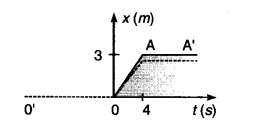Figure below shows the position-time graph of a particle of mass 4 kg. What is the
(a) force on the particle for f < 0, f>4s, 0 < f < 4 s ?
(b) impulse at t = 0 and t = 4s? (Consider one
dimensional motion only.)

Mass of particle = m = 4 kg (a) (1) For t < 0, the position-time graph is O’O which means displacement of the particles is zero, i.e., the particle is at rest at the origin. Therefore, force on the particle must be zero,
i.e., F = 0
(2) For t > 4 s, the position-time graph AA’ is parallel
to time axis. Therefore the particle remains at a distance of 3 m from the origin, i.e., it is at rest. Hence, Now force is acting on the particle for this interval, i.e., F = 0.
(3) For 0 < t < 4 s, the particle is changing its position continuously. The postion-time graph (OA) dining this interval represents uniform motion of the particle, i.e., it moves with a constant speed and thus its acceleration is zero. Therefore
F = ma
= 0 during this interval
impulse at t = 0 We know that,
impulse = change in momentum = mv - mu
= m(v - u)
Hence, u = 0 as the particle is at rest before f = 0. After t = 0, the particle has a constant velocity v where v = slope of line OA velocity at point O and point A
